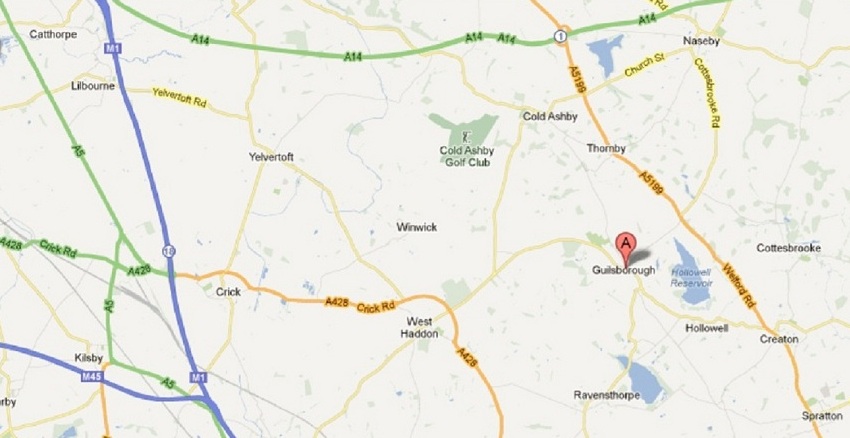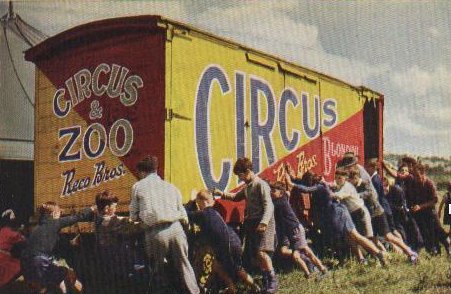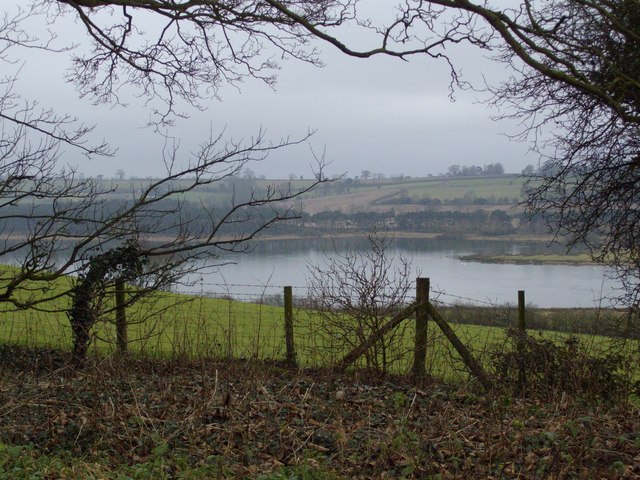Hollowell and Guilsborough Leatherlands
Introduction
John Leatherland was the fifth child of Christopher and Sarah Leatherland. He was born in Yelvertoft in 1693 and married Mary Johnson in Spratton in 1716. They settled in Creaton and had two sons and one daughter (plus a son who died in infancy). One son, Samuel, settled in the village of Guilsborough. And so began the ancestry of a succession of Leatherland families who lived in Guilsborough and its neighbour Hollowell for over 250 years. Indeed such are the Leatherland links to that area that it can be considered as the heart of Leatherland ancestry in Northamptonshire.

Guilsborough
Guilsborough lies three miles east of West Haddon and five to six miles east of Yelvertoft and Crick. Hollowell, which was originally a hamlet of Guilsborough, lies one and a half miles to the south-east.
Guilsborough appears in the Domesday book as 'Giselburgh'. Burgh/burh is an Old English name for an encampment. The Domesday entry says that it had four villagers, with three small-holders and one slave, four ploughlands, an eight acre meadow, two mills and a church.
Guilsborough includes evidence of Roman occupation : a wall forming part of an embankment which includes the remains of a Roman wall.
There are 12 Grade II listed buildings in Guilsborough including the Old Grammar School (now five houses) part of which dates from 1688, Rose Manor which has a datestone of 1688 in the door-case and a 17th century fireplace, and Manor House Farm (now a private house) which is late 17th century with 18th century alterations.
St Etheldreda's Church, Guilsbrough

St Etheldreda
John Leatherland (1693-1757)
John was born in Yelvertoft. His father was Christopher Leatherland (1654-1731) and his grandfather was Edward Leitherland (c.1630-1686). He is therefore a direct descendants of the Clay Coton and Yelvertoft Leatherlands who are my distant ancestors.
John married Mary Johnson in Spratton in 1716. (One of Spratton's claims to fame is that the great-grandmother of American founder George Washington, Amphyllis Twigden, was baptised there in 1802). John and Mary settled in Creaton and they had four children :
- John baptised 1717
- Mary baptised 1719
- Samuel baptised 1724
- Joseph baptised 1727 (died 1728)
Their son John married Lydia and had two daughters both baptised in Creaton in 1745 and 1747.

Yew Tree Cottage, Guilsborough
Samuel Leatherland (1724 - 1793)
- Mary (1758)
- John (1760)
- William (1765) – died 1766
- Ann (1766)
- William (1767)
- Samuel (1771) – died 1780
- Esther (1776)
William Leatherland (1767-1837)
A millwright designed, built and maintained mills and mill machinery. This required a variety of skills from reading plans to diagnosing and solving mechanical problems. These skills were often passed on from generation to generation.
John Leatherland (1760-1852)


Old cob wall in Hollowell
Hollowell has three Grade II listed buildings :
- Beech House in Church Hill, the former vicarage which has a datestone of 1698
- The Manor House on Guilsborough Hill which has a datestone of 1655 but many 19th century edition
- A late 17th century dovecote to the rear of the Manor House
The cob wall pictured above is also listed – it is probably 18th century. Cob was a common building material made of soil/sand/clay/straw/water and often used to build houses.

St James, Hollowell
James Leatherland (1791-1865)
William Leatherland (1818-1869)

Sheep grazing in a field overlooking Hollowell Reservoir
William was baptised in Guilsborough in 1818. Like his father he became a millwright, indeed they almost certainly worked together. He married Hannah Croxford in Bugbrooke in 1844. According to the marriage certificate she was the daughter of John Croxford, a freeholder.
On 4 December 1866 the Northampton Mercury reported as follows : Guilsborough. The Mild Season.
Although there were several Leatherlands in Guilsborough at that time, this may be William who left property including an orchard in his Will in 1869.
William died at the age of 51 only three years after his father. He left a Will leaving property in Hollowell (messuages, tennements, workshop, outbuilding, an orchard, a herediament, and premises) which were in the occupation of himself and Mrs Allen and the rest of his estate to his wife Hannah and appointed her as sole executrix. His estate was valued at £300. (Mrs Allen was probably a relative as his grandmother's maiden name was Allen).
James Leatherland (1847-1919)
 Ivy Cottage, Hollowell
Ivy Cottage, Hollowell
James was born in Hollowell in 1847. He followed in the tradition of his father and grandfather by becoming a millwright. Indeed the 1861 census shows him working at the job at the age of 13. In 1891 he was described as millwright and carpenter and in 1911 as a builder.
James possibly married Caroline Bartlett in Hollowell in 1870. They had two sons and five daughters.
James died in 1919, Caroline in 1922. The National Probate Calendar shows that probate was granted to William Leatherland farmer (probably his brother), the estate was valued at £178 10s.
Edith Anna Leatherland (1875-1924)

Edith's gravestone in St James churchyard
Edith was the third daughter of James and Caroline Leatherland. She died unmarried at the age of 49. She left a Will which left "the carpenter's shop and that portion of the yard now used by him" to her brother John, £50 to her brother James, and her house and garden with right of way through the yard, the contents of the house, and the rest of estate to her sister Helen Hardwick. (Gross estate £552, net estate £310).
James Leatherland (1876-1954)
James was born in Hollowell in 1876. He married Edith Litchfield in Hollowell in 1900. The 1901 census shows him as a carpenter / journeyman in the household of Joseph and Caroline Litchfield at Farm House, Hollowell (his in-laws). The 1911 census shows him as a 34 year old carpenter with his wife in Hollowell. He died in 1954, his wife a year later.

James' gravestone, Hollowell
James and Caroline had three sons and three daughters :
- Evelyn Amy (1900)
- Albert Edward Reginald (1903)
- Sylvia Kathleen (1904)
- William Thomas (1908)
- Ada (1911)
- Frederick John Charles (1917)
William Leatherland (1861-1937)
William was born in Hollowell in 1861, son of William and Hannah. His father died when he was 8 years old. The 1881 census shows him as a 19 year old millwright in Hollowell. At the age of 28 he married Rebecca Goodman in Leighton Buzzard. They had three sons and a daughter :
- Frank William (1889)
- George Goodman (1891)
- Catherine Lucy (1893)
- Clement Frederick (1896)

William's gravestone in Hollowell
William died in 1937. Under his Will made in 1922 when he was living at Mill House, Hollowell, he left his whole estate to his wife for life, and on her death or remarriage, he left his house, buildings and 'home field' at Hollowell to his son Clement, his two fields 'near the reservoir' to son Frank, and the remainder equally between his sons. His estate was administered by his sons both of whom were farmers. The gross estate was £1,017 with net personal estate £583.
George Goodman Leatherland (1891-1918)
William's son George Goodman Leatherland was a 9 year old boy in the 1901 census. Ten years later he was a 20 years old farmer's son working on a farm. George served in the First World War as a Gunner in the 141st Heavy Battery Royal Garrison Artillery. Sadly he was killed aged 27 in France in May 1918. He has a grave at Bagneux British Cemetery, although is also commemorated in Hollowell on the gravestone below which includes his sister who died the year before and his maternal grandmother.

Frank William Leatherland (1889 – 1973)
Born in 1889 in Hollowell, son of William and Rebecca, the 1911 census lists Frank as a 21 year old farmer's son working on a farm at Tropers Lodge, Tiffield, Towcester. Tiffield was for many years the winter headquarters of Robert Fossett's Circus. Nellie (Margaret) Fossett was also living at Troper's Lodge as a 20 year old housekeeper. She was a sister of circus owner Robert Fossett. Frank married Nellie later that year and worked as a farmer. Many of Frank and Margaret's family worked in Fossett's circus.

Reco Bros Circus (1944-45)
The circus theme was continued by Frank and Nellie's daughter, Mary May Leatherland, who married Herbert Wroe. Herbert was a tightrope walker known as 'Reco' and later became a circus owner (Reco Bros).
The Fossetts are an important circus family whose continuing involvement with circuses dates back to the mid 19th century. 'Sir' Robert Fossett was one of England's best known circus owners. In his younger days he was proclaimed to be the champion bare-back rider of the world. Fossetts Circus continues to this day and it remains based in Northamptonshire.

Gravestone of Frank William and his wife

Gravestone of Reco's wife (St James, Hollowell)
John Leatherland (1824-1903)
In 1851 John was living with his wife, a niece and nephew at Guilsborough. By the 1861 census he was a cordwainer in Guilsborough with his wife, son William, two apprentices and two visitors. A cordwainer was an 'upmarket' shoemaker who made luxury leather shoes. Maria died in 1886. John remained a shoemaker living in Guilsborough until his death in 1903.
John Leatherland (1854-1910)

John's Gravestone in Hollowell
John was the son of William and Hannah Leatherland. He was born in Hollowell around 1854, although I haven't managed to trace his baptism or birth registration. In 1871 he was a millwright living with his mother in Hollowell. He married Eunice Bent in 1878 and they had three children. Following her death in 1891 he remarried Eliza Green seven years later. He remained living in Hollowell and worked as a joiner / builder. He was living next door to his brother William in 1901.
He was buried in Hollowell in 1910.
Margaret Ellen Leatherland (1922-1992)
Margaret was a daughter of Frank and Margaret (nee Fossett) Leatherland. 
Summary
Several Leatherland families lived in Guilsborough and Hollowell from the 1750s until the 20th century. Unlike the Yelvertoft / Crick / Kilsby / Pailton Leatherlands (who were mainly farm labourers and – in Crick – weavers), they were predominantly millwrights / wheelwrights and later carpenters / builders.
There are still three Leatherland families in the area :
George Leatherland who owns and runs Pastures Farm
Brothers Jim and Ken Leatherland who still live in Hollowell – they used to run a local building firm
Kevin Leatherland a sheep contractor who lives in Hollowell and works at a farm at East Haddon (possibly as Leatherland & Son)
There is still a Leatherland building firm FJC Leatherland & Sons based in Upper Weedon, Northants. 
Hollowell Reservoir
Hollowell Steam Rally
Hollowell holds an annual Steam Engine Rally and Heavy Horse show every July. The Rally was started in 1986 by Allen Eaton MBE in response to a request for a donation from the Warden of Hollowell Church for repairs to the roof. On the grounds that there were only 100 households in the village and the sum required being £5000, Allen declined to donate the requested £5 but he offered to organise a steam rally instead.
Hollowell Steam and Heavy Horse show is now more than just a steam rally. From the original 11 acre site including car park, it has grown into almost 100 acres of family entertainment, with 40 steamers, around 30 Heavy Horses, over 100 tractors and an auction.
Allen Eaton is a well known member of the steam preservation movement. He has a private collection of three steam engines and still lives in the area. The 2012 rally included 50 steam engines including ploughing engines and steam rollers.
The Guilsborough Witches
On 22 July 1612 four women and one man were hanged at Abingdon Gallows, Northampton for the crime of witchcraft. Two of the five women : Agnes Brown and her daughter Ioane/Joan Vaughan (or Varnham) were from Guilsborough. They were accused of bewitching a local noblewoman, Elizabeth Belcher (née Fisher) and her brother-in-law Master Avery and of killing, by sorcery, a child and numerous livestock.
Although the hangings can be legitimately traced back to actual historic events, the story most commonly repeated is of less certain origins. The tale is that there was an elderly witch called Mother Roades, who lived just outside Ravensthorpe. Before she could be arrested and tried for her crimes of sorcery, she died. Her final words told of her friends riding to see her, but that it did not matter because they would meet again in some other place before the month was out. Her friends were apprehended riding on the back of a sow between Guilsborough and Ravensthorpe. They were taken into custody and hanged.